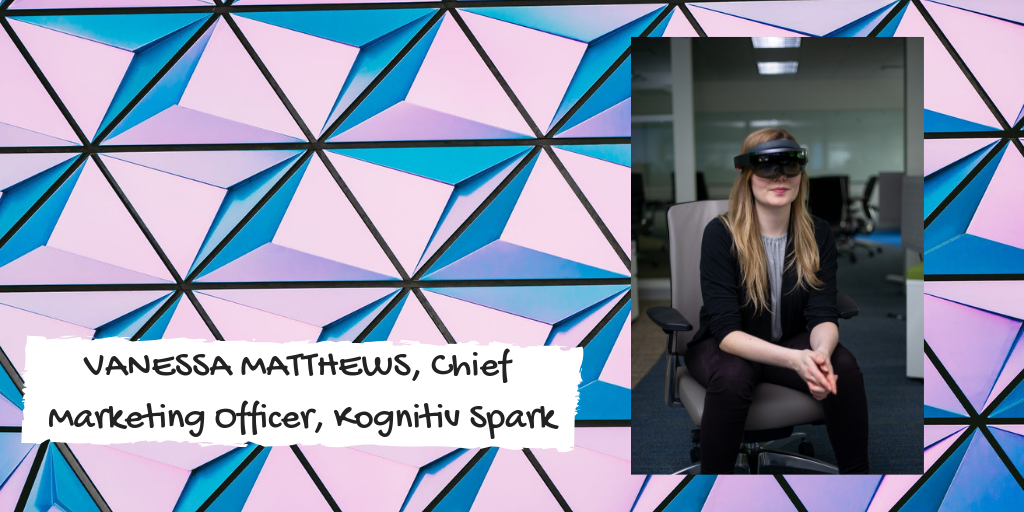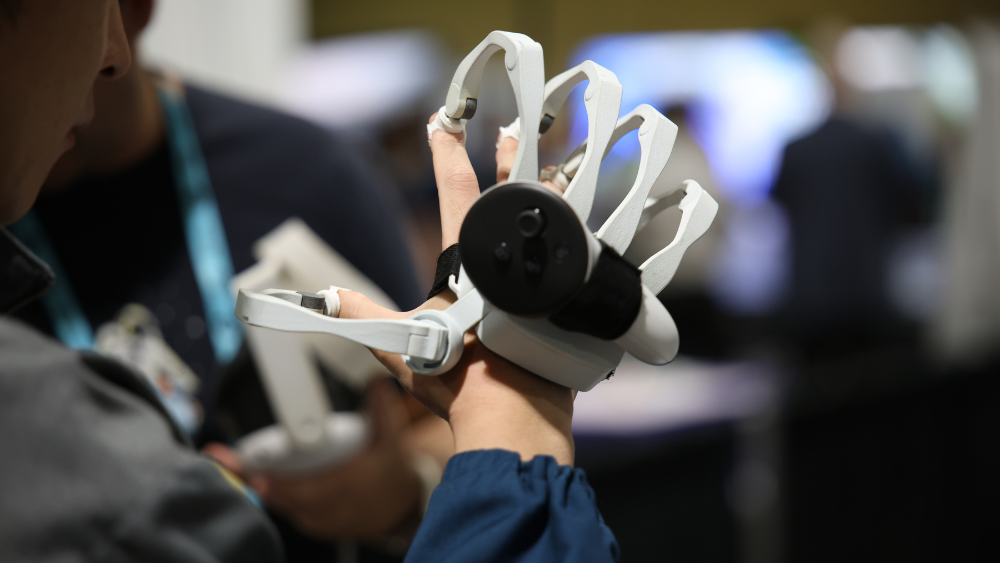Vanessa Matthews, Chief Marketing Officer, Kognitiv Spark
Emily: To begin, could you provide us with a little background on yourself and your career?
Vanessa: I'm the Chief Marketing Officer for Kognitiv Spark. We leverage AR/VR to deliver secure holographic industrial worker support that improves operational efficiency, accelerates troubleshooting, and empowers workers to unlock their greatest potential.
What sets us apart from other AR solutions for enterprise is our military-grade security features that protect an organizations' intellectual property and data, our ability to perform mixed reality support calls with 3D content and annotations, our ability to tap into live IoT sensor data and render it on holographic digital twins, and our performance reliability under low bandwidth conditions and in remote environments.
I've spent several years of my career working in the technology field. Innovations in tech are so exciting because you're blazing new trails, and there's no best practices or old roadmaps to follow - which is especially exciting from a marketing perspective. My team and I are responsible for defining how this technology is communicated and how the market defines this industry. It's a blank slate with so much opportunity.
Emily: What is it like as a woman working in AR/VR?
Vanessa: While there are still too few women working in AR/VR and the spatial computing industry as a whole, I must say I've been pleasantly surprised to find communities of women supporting each other in this space and many successful women who have been serving as role models for girls and younger generations entering the workforce and STEM fields in general.
Coming from the PR and marketing side of tech, I know that the contributions of women have historically been and are still often overlooked. You don't have to be writing code to be contributing significantly to the evolution of a tech company or emerging industry, and I think that's something everyone needs to hear.
The great thing about being a woman working in AR/VR is that the industry is so new it has the potential to be a level playing field among genders. People, regardless of gender, have the opportunity to develop expertise at the same rate as anyone else. The industry is taking shape every day and it's great to hear and support the strong female voices that are clearing the path.
Emily: What challenges do you face that your male colleagues or peers don't?
Vanessa: Women can sometimes be left out of key decisions made amongst male colleagues after hours. I think many could argue that women are even more excluded from these conversations in the era of #METOO, their male colleagues now with a fresh fear of being accused of inappropriate behavior.
Although I've never felt penalized for being a woman, there have certainly been situations in which I've been invited to the table but either not allowed to play or only allowed to play under "old boys' club" rules.
Generally, women are still facing challenges when it comes to equal pay for equal work, a lack of women in tech company leadership (and leadership in general) and lack of VC funding awarded to women-led startups.
Emily: Have you ever felt judged or overlooked because of your gender?
Vanessa: I've certainly felt judged and I've been underestimated on a number of occasions throughout my professional life.
Although I've never noticed being overlooked for an opportunity because of my gender, that doesn't mean I haven't been. Unconscious bias runs deep in everybody regardless of gender, so I wouldn't really be able to comment on having been overlooked for being a woman.
I have noticed that, because I'm a woman, I'm subject to different expectations regarding my approach or leadership style. Assertive and confident actions that would be considered strengths for male counterparts are considered aggressive for women. The counterpoint - a friendly or more nurturing (AKA stereotypically) feminine approach - can be seen as weak and is often devalued.
Emily: What about the user experience for women; how do the devices fit and perform for women?
Vanessa: I'm mostly familiar with the Microsoft HoloLens and I can't say that I've noticed any challenges with how the device fits and performs for me or our female end users. Our software was built with industrial workers in mind. Both men and women use our solution and we receive very similar feedback from each end user.
Emily: What is the most critical issue for women in AR/VR?
Vanessa: I think it's keeping the momentum going and consciously working to make it a welcoming space for more women to join. Staying the course of promoting women in this space is the most important task that all of us must undertake.
If you want to change the game, add more players. That's exactly what women in tech and AR/VR need to keep doing. The more strong female voices in our industry and tech in general, the better. I think the responsibility falls on every woman in this space. We need to keep being vocal, keep lifting each other up and promoting one another, keep mentoring others and keep innovating.
Emily: Do you believe there's a lack of content for women AR/VR users?
Vanessa: I think the lack of content is from an entertainment/consumer perspective. I work in the AR/VR for the industrial sector and the software is very much geared towards manufacturing and construction - fields that generally lack female representation - though we do have female technicians who use our solution.
Emily: What is your advice to women working in AR/VR?
Vanessa: Mentor another woman looking to get into the space. We have to support one another. Even though we constantly feel like we need to prove ourselves, resist the urge to be competitive with one another. We need to life each other up. It's been great seeing this shift in the tech space.
Also, be yourself. Authenticity and diversity of thought, opinion, perspective and approach will benefit everyone in your organization and industry. Don't feel like you need to compromise your approach or opinion and behave by male (or anyone's) standards, and don't be afraid to stand up for yourself and call someone out on sexist behavior in the workspace.
Emily: What would you like to say to men in the space? What should they be doing to help women in tech?
Vanessa: Privilege is invisible to those who have it. This obliviousness can often keep us from taking a stand alongside women or other less privileged members of society. As a white woman, I certainly have privilege, too.
Men in our space need to understand that AR/VR companies that have more gender parity and diversity have a high rate of return on investment, higher profitability, and better job satisfaction (which results in less employee turnover). There is plenty of evidence to support this - diverse businesses deliver 35% better results than non-diverse businesses.
Often, hiring 'the best person for the job' isn't enough. Consider hiring based on the value a candidate can add to the greater team and company culture, rather than simply in a specific role. Each and every one of us has to understand that we have unconscious bias and learn to recognize that bias as best we can. Most people will unconsciously hire someone in their own image; try to look for complimentary skill sets that will make the whole team stronger rather than a carbon copy protégé.
The best way to help women in tech is to give credit where credit is due, question unconscious bias, support us in the workplace, and champion us internally.
Emily: What is your greatest hope for the future of AR/VR?
Vanessa: I hope that the AR/VR space continues to push towards improving connectedness, comprehension and clarity, and avoids creating disconnect and isolation like we've seen with many technologies before.



